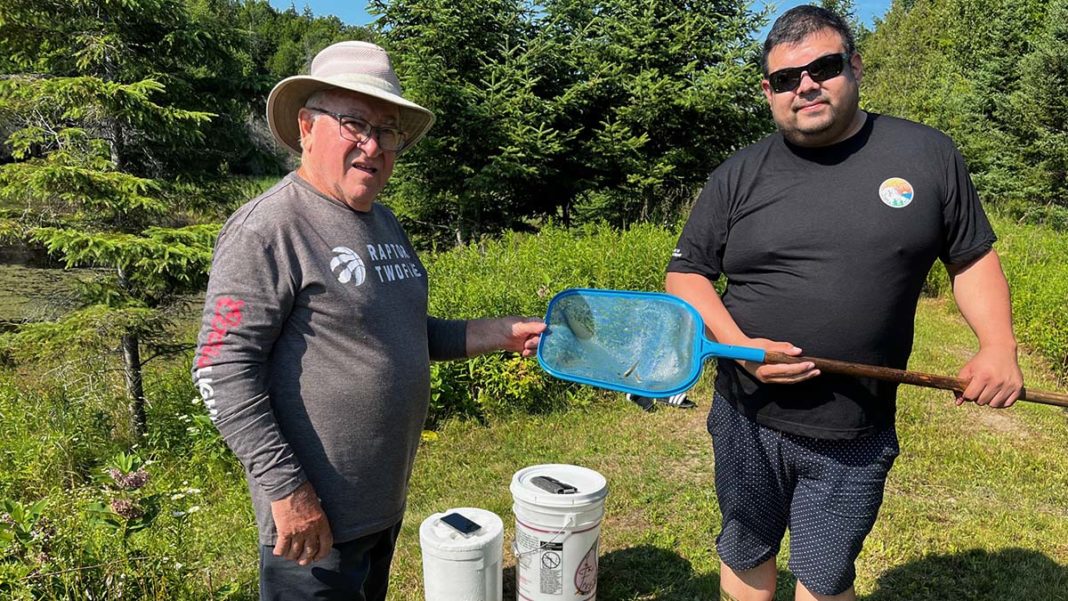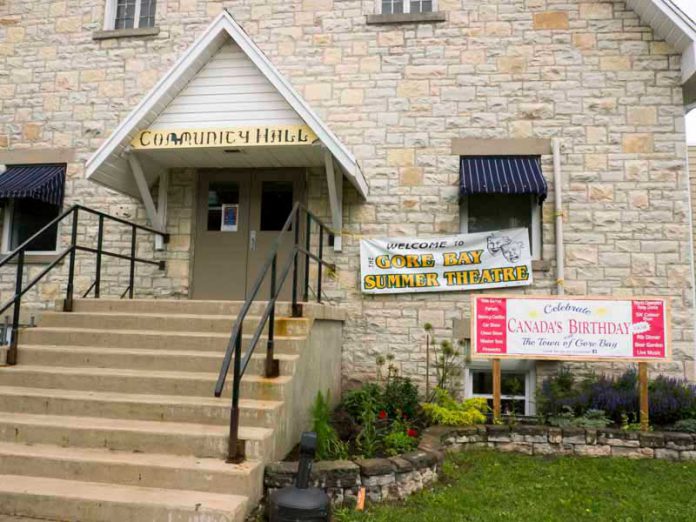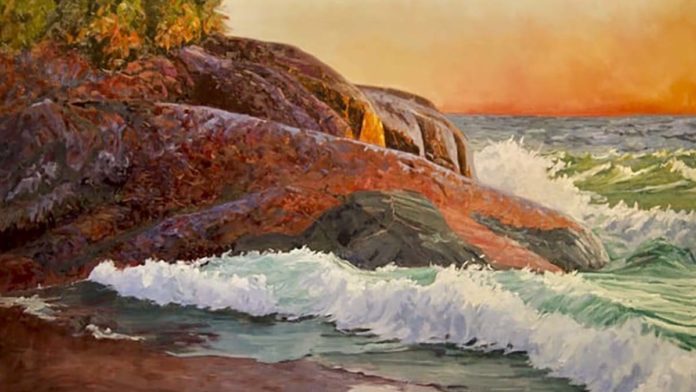Birch Island, Whitefish Falls Sportsmen join forces
WHITEFISH FALLS—Keith Nahwegahbow looks up from the pond where he and several other men are dipping nets into the water, trying to retrieve walleye (hatchlings). “Nothing,” he says. Usually they’d have caught about 25,000 walleye by this time. It’s about 10 am on Saturday morning. He’s at the Whitefish Falls Sportsman’s Club (WFSC) hatchery, located in the valley at the base of Willisville Mountain, where the old highway used to run. It’s only used by the hatchery now.
“When the water level is down this low, we should have about 25,000 ready to release into the lake already,” explained John Perfetto. He’s president of the WFSC, which started the walleye release program in 1989 and Mr. Perfetto took it over in 1999 (as president). This is his last year—Dennis Nicholson will be assuming the role. Whitefish River First Nation (WFRN) came on board about four years ago, although they’ve been working with their own hatcheries for longer than that.
Mr. Nahwegahbow lifts his net. He’s got two tiny walleye on it. They’re about three inches long and quite feisty. He puts them in a pail of water. Each pail will hold about 500 fingerlings that will be transported to the North Channel for release. They’re allowed to put walleye in the North Channel as that is where their eggs come from.
The fish are there, Mr. Nahwegahbow says. He points into the water. “Look at all the little ones. They’re just hard to catch. I think we grew them a little too long this year. They’re feisty.”
“They’re beautiful,” added Mr. Perfetto. “If we get 30,000 of those, it’ll be something.”
“Walleye are carnivorous,” he added. “If there’s no food available they’ll start eating each other. It doesn’t make sense now because there’s lots of food available. Timing is very important for this kind of work. It’s all temperature dependent, when to start. It’s never the same day each year. It’s always different.”
This batch of fingerlings is from the Ministry of Natural Resources (MNR) but WFRN actually catches and raises their own as well. They catch walleye in the river to gather eggs that they raise in their four micro-hatcheries. Mr. Nahwegahbow coordinates the micro-hatcheries as well as the walleye release program. The micro-hatcheries probably have the potential to raise successfully 1.6 million walleye, although this year, they were only able to do about 25 percent of that due to weather and other unforeseen issues.
This walleye rearing program is completely voluntary, noted the WRFN team. The WRFN team is involved because they believe in stewardship for our future generations. “We must look seven generations ahead.” It takes approximately 120 days to get through the process to be able to release the walleye into the North Channel, and it is is crucial that the walleye fry are taken care of during this time.
It’s hard work, environmental technician Mskwoka McGregor said. “It’s not easy. There’s a lot of man hours involved, a lot of time in the water and a lot of physical labour.” But the work has its rewards. When he’s out fishing and reels in large walleye, or sees another fisherman do so, there’s satisfaction in knowing “I could have grown that.”
“That’s the part people don’t see,” added Mr. Nahwegahbow. “We put a hundred days of effort into this. Today is fun, but people don’t see the effort.”
During previous employment as a fish technician, Mr. Nahwegahbow studied the river. “We’ve been collecting data since 1999,” he said. “Our data shows that the walleye is a healthy population but they are missing certain healthy population traits. There’s a very high ratio of male to female, which is concerning. The females are the main contributors to the population.”
He explained this could be due to a number of factors but attributes much of it to trophy fishing. “Females are the biggest fish,” he noted. As a recreational angler or a sportsfisherman you’re allowed to catch your one big walleye, which is typically female. Other reasons could include overpressure on the spawning population, fishing pressure, climate change, all these are factors.
“What I notice about climate change is that it’s changing the timing of everything,” said Mr. Nahwegahbow. “Normally walleye spawn in late April, mid-May. Due to climate change, it’s been pushed back a couple weeks. Now they’re spawning into mid-May and the May long weekend. They’re still spawning when fishing season opens.”
He’d like to see more protection around the river itself, just to give the spawning population an extra chance by helping them spawn before they’re fished out. “This is the reason why we’re doing this,” he said. “We want people to fish. All our efforts in the past 20 years have been keeping up with fishing pressure. We’ve seen no changes or drastic changes in the population of walleye, but what would happen if we stopped doing all this? We don’t want to find out, so we’ll just keep doing what we do.”
He wants to do more habit assessment in Whitefish River itself in the future. That’s the main spawning bed. The walleye swim up the river and spawn at the base of the falls. Future work is being planned to quantify that spawning habitat, he said. “If we’re going to release a million walleye per year in that location, how much can actually spawn there? We want to maximize our effort. If we find that stocking them is useless because we’re stocking way more than the system can handle, then we can look into protecting them somewhere else, doing habitat enhancement or we could work on different species of fish if the walleye is good.”
It’s really up to the community where his efforts are directed, he said. “They want an effort on walleye so I’m working on that but if they would like me to work on something else I would do that.”
WRFN Chief Franklin Paibomsai stopped by. He said he looks forward to this day every year. “Water is life,” he said. “That’s your story. It’s not the walleye. When I was growing up here, we heard about the walleye.” He remembers his uncle’s stories of catching walleye this big (he demonstrates with his hands far apart). “He didn’t have to go far to get them, and then they evaporated,” he said.
John Perfetto agreed. “They’re gone,” he said. “When I came here in 1988, there wasn’t, I couldn’t get any. Then we started this.”
It was like the Sasquatch, Chief Paibomsai explained: often talked about, seldom seen. “That’s what it was about walleye. Everybody was bass fishing and pike fishing. You know what wasn’t happening? We weren’t building relationships. It’s about relationships: relationships to the land, relationships to the water, relationships to our spirit, relationships to our insides, our inner being.”
It’s also about relationships with others, he said. With people like Bill Strain of the Little Current Fish and Game Club, and Rolly Frappier, who brought the micro-hatchery program to Shawanosowe School. “Rolly Frappier, his work continues. He’s retired now and says ‘Frank, I’m still committed to this. I still love doing this’.”
Chief Paibomsai invites people to volunteer in this or any other environmental program. “Join our hands, we have open hands here,” he said. “Ask us how do I start something, or how do I do something in my school? We need everybody, right? This is not a spectator sport. We need everybody, because it’s too beautiful for us just to let it go. It’s far too important for our young people.”
One year there was a community meeting on the fishery, Chief Paibomsai said. “I told them we can be the generation that said we ended it or we can be the generation that says, we’re beginning it. That night they said, let’s begin. Let’s begin. That’s the fundamental message.”
A family has joined in the fun, and a visitor from Sagamok. “Look at them,” Chief Paibomsai said. “They’re all big kids. They’re having a blast. And why not on a Saturday? The mining company should be investing in this. Where are they? Vale is doing speckled trout. They should put some in here as well. Look at the habitat here. The turtles, the snakes. Look at that snapping turtle, right in front of us. This is a rewarding opportunity.”





